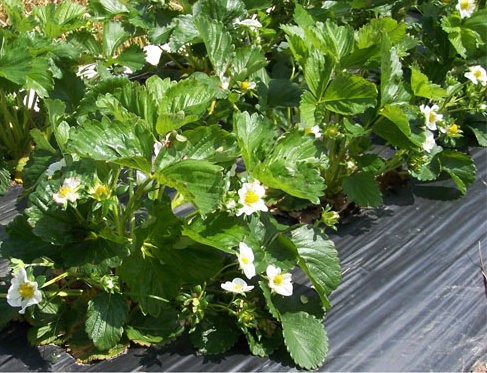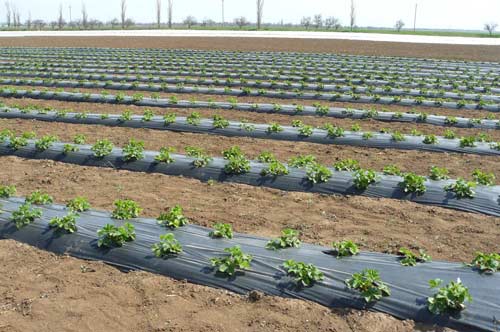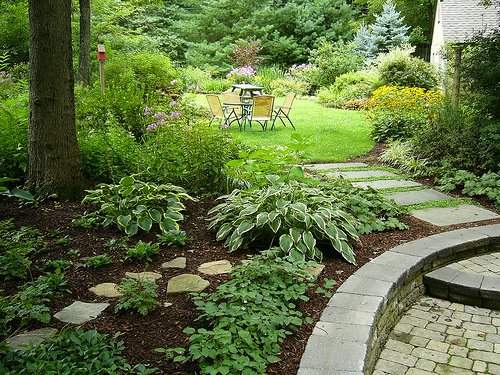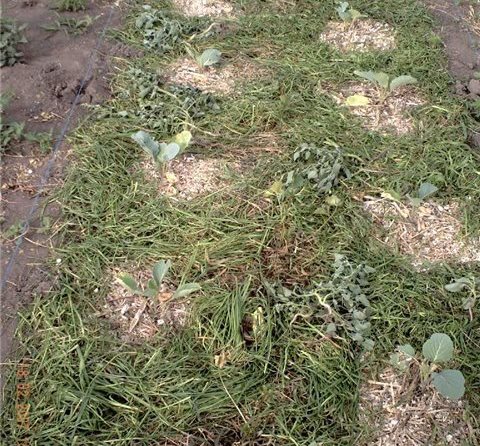One of the important stages of the care of its own plot - mulching. Features of such technology are to create a surface layer around planted crops to ensure stable circulation of air and moisture. The whole procedure is quite simple - it is enough to choose any material suitable for this purpose and follow the recommendations that are aimed at defining the thickness of the shelter created and the time of its formation.
Content
Why do the soil mulch?
The reasons for which it is recommended to regularly carry out such work quite a lot.
Carefully read the most important nuances to determine the importance of timely and proper mulching:
- An obstacle to excessive evaporation of moisture after watering.
- Protection of the root system of plants from overheating and freezing.
- Regulation of soil acidity.
- Enriching the Earth with useful substances.
- Improving the structure of the soil.
- Preventing the flushing of useful trace elements from the soil in places of planting crops.
- Protection against pests and expanding weeds.
- Prevents the rotting of plants and fruits on the surface of the soil.

Important! Separately, we note a significant increase in the attractiveness of the entire area when mulching. A particularly spectacular result is obtained in the case of the use of decorative mulch from a colored crushed stone or other stone.

What are the types of mulch?
The main criterion for the classification of mulch types is the nature of origin. According to this principle, two main types are distinguished:
- organic

- inorganic.

Important! Choose a suitable type for use, considering the features of planted crops and the availability of materials.
Where is the mulching required?
The main feature of such a direction for the care of the soil is the need for a coating on various types of sites. For example, the soil mulch is often carried out in a greenhouse, since, in a closed space, it is very important to properly adjust the conditioning of the soil. 
Important! Such a simple procedure can significantly increase the volume of the crop and improve the quality of the fruit.
In the open area, also apply the mulching technology, especially in the case when the composition of the soil introduces difficulties in the conditions of its operation for growing different cultures. 
What materials use to prepare mulch?
To perform this work, apply any available material, the main criterion for choosing which determine the purpose of creating a mulch. For example, to increase the nutrition of the soil of the garden landing, prefer materials for organic origin.
If the main task is to decorate flower beds - use more attractive types of mulch. 
Important! Note that the recommendations for the layer thickness will be varied for each material.
Types of inorganic materials to create mulch
Several types of particular popularity are particularly popular:
Recommendations for the use of inorganic materials
If you prefer one, from these species, familiarize yourself with the preferred direction of use:
- Perform the soil mulch with the black film of the porous structure when designing beds in a greenhouse or planting berry bushes. The use of such technology will allow not only to ensure good retention of moisture in the ground, but also will increase the percentage of survival of cultures.
 In the early spring season, roll the cloth only for the night to ensure sufficient natural heating of the soil and the flow of nutrients in the afternoon and save the heat until the morning. In a sultry summer heat, be careful in the use of black film, as it increases the temperature of the soil by 2 degrees and can provoke overheating of the root system. For watering crops, give preference to a drip method, but regularly check the absence of slugs under the coating.
In the early spring season, roll the cloth only for the night to ensure sufficient natural heating of the soil and the flow of nutrients in the afternoon and save the heat until the morning. In a sultry summer heat, be careful in the use of black film, as it increases the temperature of the soil by 2 degrees and can provoke overheating of the root system. For watering crops, give preference to a drip method, but regularly check the absence of slugs under the coating.  The lining of the soil with black film is great for the following plants:
The lining of the soil with black film is great for the following plants:
- When choosing a mulching stones, give preference to those that best be combined with all the rest of the landscape. In this regard, the shade and size of rocks are very important. Also note that this method is not suitable for poor soil when planting vegetable or berry crops, since this mulch does not bring any nutrients and makes it difficult to get into the deep layers of the Earth. The perfect solution for using stones is to decorate flower beds on sandy soils. In this case, solid rocks, especially small fractions, will serve as a natural drainage.

Important! Browse the video in which the process of decoring the mulch from the black film on the beds is clearly shown.
Organic Mulching Mulching Soil
A species series of organic materials suitable for creating mulch, wide enough.
Therefore, we give an example of only some of the most demanded options in the list below:
- Compost
- Freckled grass
- Straw
- Newsprint
- Coniferous needles
- Wood bark
- Sawdust
- Sheet humus.

Important! Despite some advantages of artificial materials, which are primarily in ease of use and minor time spent due to the lack of need for long-term preparation of material, most land owners still prefer natural materials. This approach allows not only to make landing care maximum convenient, but also makes it possible to regulate the chemical composition and the structure of the soil, increasing its fertility.

Recommendations for the use of organic materials
Carefully treat the decisions proposed below for the formation of mulch for specific types of plants. This will help avoid mistakes and create the type of protection that will be the best solution for the benefits for cultures and the time occupied to its arrangement and update.
Moving methods with different organic materials:
- Soil mulch with newspapers is one of the most low-cost ways. The main benefit of this method is to effectively combat the growth of weeds and holding heat in the soil. To form a mulch, use colored or black and white prints in a sheet or crushed version. The average thickness of the layer is 4-6 sheets.
 The use of such material is suitable for growing the following crops:
The use of such material is suitable for growing the following crops: - Apply the compost to create a mulch in the case when the amount of nutrients in the ground significantly decreased and this is reflected in the yield. In addition to the compost - a great option for mulching, it also applies to a group of very effective fertilizers. Therefore, the use of such a mass will significantly save on additional fertilization of plants. It is noteworthy that the compost is ideal for any type of crops without restrictions, but it is especially valuable to get a good harvest of vegetables and berries.

Important! The only nuance, which we note in the form of a disadvantage - is required at least 7 months for its preparation, and this procedure is not very pleasant.

- Use for mulching a straw if careful maintenance of the temperature regime is required and an effective opposition to the reproduction of pathogenic bacteria and pest beetles. Preferring this method in the cultivation of the following cultures:
- In the case when on the site, one of the parts is decorated under the lawn, the rational solution will be mulching with excessive grass sprouted after each pouch. If you have taken such a decision, keep in mind that it is required to withstand a day or two so that it dries a bit. This approach will prevent its rapid rotting on the beds.
 Covering mulch only after the soil warmed well - otherwise its temperature will be 2-3 degrees below than air. Among the advantages of this organic material, we note excellent moisture regulation, such a valuable for the full development of many plants, and scaring the pests. Be sure to regularly update the layer as the grass is overloaded.
Covering mulch only after the soil warmed well - otherwise its temperature will be 2-3 degrees below than air. Among the advantages of this organic material, we note excellent moisture regulation, such a valuable for the full development of many plants, and scaring the pests. Be sure to regularly update the layer as the grass is overloaded.  This option is well suited for cultivation of such cultures:
This option is well suited for cultivation of such cultures:
- The soil mulch is a crust - one of the most durable and efficient ways. Moreover, the aesthetic side is equally important, therefore, this material is widely used to decorate the plots along with stone rocks.
 The advantages of mulch from the cortex will take the stability of the temperature regime - it prevents and overheating, and freezing. Also, it is also impossible not to note the lack of the need for constant coating over 2-3 years. Make a layer with a thickness of 5-6 cm, preferably made of pine bark.
The advantages of mulch from the cortex will take the stability of the temperature regime - it prevents and overheating, and freezing. Also, it is also impossible not to note the lack of the need for constant coating over 2-3 years. Make a layer with a thickness of 5-6 cm, preferably made of pine bark.  Be sure to prefer this method to arrange a plot with such plants:
Be sure to prefer this method to arrange a plot with such plants:
- The use of false foliage is no less valuable than the use of grass, but the layer will be needed much thicker. In the process of rotting, all necessary nutrients are formed, which affect not only the development of different cultures, but also contribute to the increase in the fertility of the Earth. Separately, we note the fact that with the autumn decoration of mulch from foliage, such a coating will prevent the rapid germination of bulbous crops during early thaws, that is, protects them from death.
 It is impossible not to note a significantly lower time spent in the spring period, since new seedlings can be completely boiled into the thickness of the soil under the autumn mulch, and not form a new one. If there is a sufficient amount of deciduous trees on the site, use this type of mulch when landing the following plants:
It is impossible not to note a significantly lower time spent in the spring period, since new seedlings can be completely boiled into the thickness of the soil under the autumn mulch, and not form a new one. If there is a sufficient amount of deciduous trees on the site, use this type of mulch when landing the following plants:
- When mulching the soil, sawdust carefully take care of the quality of this material. First of all, we note that it is impossible to use fresh sawdust or those that have long lay in a pile. Initially, they dry them, laying up a thin layer. Pull with wood sawdust or sins only those areas that are not subject to frequent processing.
 An interesting decision will be to use such a mulch on the beds with winter crops and under some kinds of berries and colors:
An interesting decision will be to use such a mulch on the beds with winter crops and under some kinds of berries and colors: - garlic
- onion
- strawberry
- tulips.

Important! Please note that sections with mulching sawdust should be affordable - otherwise all small particles will quickly scatter through adjacent territories. Also another disadvantage of this method is to endure sawdust and as a result of the reduction of their protective function in the activities of some microorganisms.

- Coniferous needles are another of the most available materials for making mulching. They provide reliable protection against drying and freezing the soil and root system of plants. It is believed that coniferous needles strongly increase the level of acidity in the ground, which is not fully justified - in fact, this indicator is not as significant in order to abandon this material. More attention is paid to volatile substances that allocate all plants of this type, which can adversely affect the development of some cultures, for example, tomatoes.
 However, coniferous needles are an excellent option for the following types of plants:
However, coniferous needles are an excellent option for the following types of plants: - potato
- raspberries
- strawberry
- asparagus
- flowers
- eggplant
- strawberry.

Important! Please note that it is not at all necessary to give preference only to one material. If there are several options in sufficient quantities, make a combined coating. With this approach, you will most likely be able to achieve an excellent result and in relation to increasing yields, and the attractiveness of the entire landscape.

When is it better to mulch the soil?
According to the rules, mulching is carried out twice a year:
- in the spring, during planting plants
- in the fall, before the onset of frosts.
Important! Despite the standard prescriptions, the appropriate time to perform work in this direction, select, depending on the type of material used.

Be sure to consider the need to update the coverage:
- For wood bark, the frequency is determined by 1 time in 3 years.
- When making a mulch from bevelled grass, it is advisable to add material every 2 months. The use of black film is not limited, but be sure to remove it regularly to assess the state of the soil.
- Stone mounds. Delete only when changing the layout of the landscape or planting new crops.
- When using wood sawdust or coniferous needles, pay attention to the decrease in the thickness of the layer during wind gusts.
- Composts are introduced twice a year, but if necessary, add the material in the process of vegetation of plants or ripening fruits.
- Perform update covering of straw in the case could not avoid its decay during heavy rains.

Conclusion
No matter what it is material for mulching you prefer, carefully follow all recommendations of the arrangement of the site. In this case, you do not have to exert extra effort to save their crops or decorative appeal of the landscape.
































